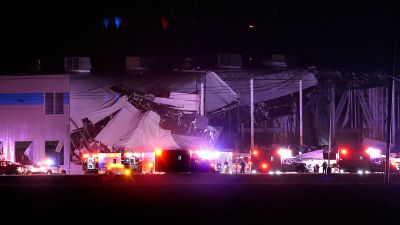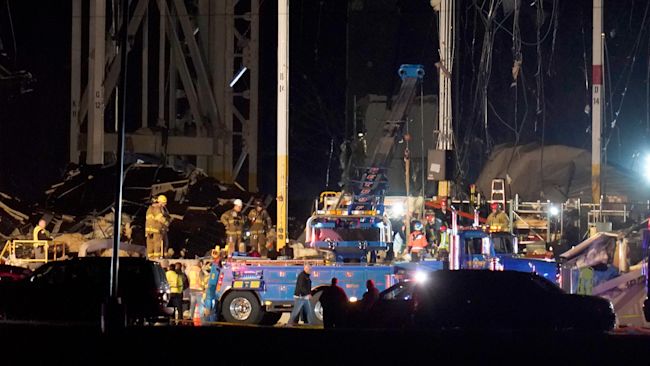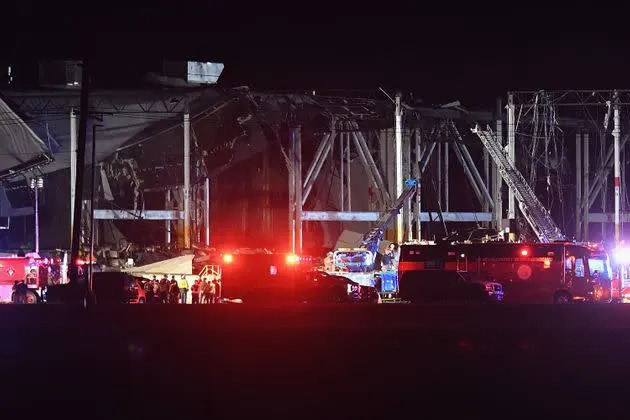Serbia roads blocked for 3rd weekend of lithium mine protest
Via AP news wire
Sat, December 11, 2021

Serbia Protest (Copyright 2021 The Associated Press. All rights reserved.)
Environmental protesters blocked roads in Serbia for a third consecutive weekend to oppose plans for lithium mining, despite a bid by the country's populist government to defuse the demonstrations by agreeing to the key demands of organizers.
Several thousand people braved rain and cold weather Saturday to halt traffic in the capital, Belgrade and in other cities and towns in the Balkan nation.
The protesters want the government to fully remove any possibility of companies initiating mining projects. Environmentalists argue that extracting lithium, a key component in electric car batteries, causes huge damage to mined areas.
Serbian authorities withdrew two key laws that activists said were designed to help multinational mining company Rio Tinto open a mine in the country's lithium-rich west. Fewer people showed up at Saturday's demonstration compared to the two previous weekends, reflecting a rift among protest leaders over how to proceed.
“There will be no peace until exploitation of lithium is banned and Rio Tinto sent away from Serbia,” Aleksandar Jovanovic, one of the organizers, said.
Serbia's autocratic president, Aleksandar Vucic described continued protests as “political” after the government gave up on the two proposed laws, which involved property expropriation and referendum rules. Vucic said people would have a chance to express their preferences during the next election in April.
Serbia must tackle its environmental problems to advance toward European Union membership. Vucic has said he wants the country to join the EU, but he has also fostered close ties with Russia and China, including Chinese investments in mines, factories and infrastructure.
Environmental issues have come into focus recently in Serbia and other Balkan nations because of accumulated problems from air and water pollution. Protesters argue that authorities favor the interests of foreign investors and profit over environment protection.


Miodrag SOVILJ and David STOUT
Fri, December 10, 2021
Farmhouses and cornfields dot the gentle, rolling plains of Serbia's Jadar Valley, but underneath the bucolic surface lies one of Europe's largest lithium deposits -- the source fuelling the latest round of unrest in the Balkan nation.
The future of the vast mineral deposits near the city of Loznica has become the latest flashpoint in Serbia, pitting festering distrust in the country's increasingly autocratic government against Europe's plans for a greener future.
Billions are at stake with Anglo-Australian mining giant Rio Tinto boasting that the project has the potential to add a full percentage point to Serbia's gross domestic product and provide thousands of jobs.
In a matter of years, this impoverished corner of Serbia nestled against the Bosnian border could be transformed into one of the industrial engines turbocharging Europe's transition to lower-carbon technology considered vital for a greener future.
Lithium is a key ingredient for batteries powering electric vehicles and storing renewable energy, with soaring demand for the mineral setting off a "white gold rush" as automakers scramble to secure sufficient supplies to meet their ambitious goals to roll out new fleets in the coming years.
But environmental activists and locals living near the future mining site have accused Rio Tinto and President Aleksandar Vucic's administration of cloaking the entire project in secrecy and refusing to release environmental assessment reports.
The lack of transparency, locals argue, is stoking fears the mine may leave their land in ruins.
"If the Jadar project goes through, everything will be destroyed around us," Dragan Karajcic -- a community leader in the village of Gornje Nedeljice -- told AFP.
"Wherever Rio Tinto operated, it left a wasteland behind," he added.
- Power struggle -
In Serbia, the mining project has tapped into simmering anger against Vucic. Thousands have swarmed key roads across the country in recent weeks to voice their opposition to the government's handling of the project.
Violent attacks by masked men against a demonstration in the western Serbian city of Sabac in late November sparked outrage on social media along with accusations the government was relying on hooligans to squash dissent.
With elections likely coming early next year, Vucic has sought to blunt the mounting pressure, vowing to remove amendments to one law and scrap another piece of legislation that protesters argued were written to provide favourable conditions for Rio Tinto.
The leader has also insisted the mine's future is up for debate.
"I will have to sit down and see whether we essentially want this mine or not," the president said late Wednesday.
Getting to the minerals will be no easy task, requiring extensive excavation to supply enough lithium to power more than one million electric vehicles per year, according to Rio Tinto.
The area nearby is also home to extensive borate reserves needed for the production of solar panels and wind turbines.
The mine is set to be located along the Jadar River, a tributary of the much larger Drina -- a vital source for agricultural production in both Serbia and neighbouring Bosnia.
Any contamination caused by the project along the banks of the Jadar would be felt much wider afield, activists argue.
Rio Tinto has sought to allay rising fears over the project, promising to uphold the "highest environmental standards", according to a statement posted online.
But residents in Gornje Nedeljice say Rio Tinto's track record has given them pause.
In recent years, the mining giant has been mired in controversy, with a public backlash and investor revolt forcing the company's chief executive and some top officials to step down after the firm destroyed a sacred indigenous site in Australia last year.
Critics of the mine also point to the Vucic government's poor track record with regulating its industrial sector as Serbia courted Chinese companies to invest in the country.

Access forbidden -- danger! warns a sign in front of a house sold to Rio Tinto, which has been paying top dollar to buy property where it wants to mine

-'Nobody’s dump'-
In Gornje Nedeljice, signs saying: "No to the mine. Yes to life" hang throughout the village, where Rio Tinto has been buying up large swathes of land -- offering virtual fortunes for residents' plots that would fetch just a fraction of the price elsewhere.
The company is set to break ground on the mine next year, but is still awaiting the final green light from Belgrade.
Rio Tinto has promised the project will provide over 2,000 jobs during its construction phase and another 1,000 mining and processing jobs once it is operational.
But for Gornje Nedeljice resident Marijana Petkovic and others, the mine's potential benefits put their community's health and environment at risk at the behest of their wealthier European neighbours.
"Serbia needs to realise that we're nobody's dump for mining," says Petkovic. "Not Europe's, nor the world's."
ds/rl/spm


Civic activism in Serbia gives headache to ruling elite
Aleksandar Vasovic
Fri, December 10, 2021
By Aleksandar Vasovic
PRANJANI, Serbia (Reuters) -From her village home in southwestern Serbia, Ljiljana Bralovic keeps watch on snow-covered hills and a network of small roads, looking for unfamiliar cars she believes might be carrying geologists prospecting for lithium.
Environmentalist groups like the one in her village threw up roadblocks there and across Serbia for two straight weekends in protest at laws meant to ease multibillion dollar projects by foreign miners to extract lithium, borates and copper. More protests were scheduled for Dec. 11.
The blockades in late November and early this month prompted the conservative government to backtrack this week on two laws environmentalists see as beneficial to exploitation of local resources with scant regard for the risk of worsened pollution.
In the village of Pranjani, Bralovic and activists of the Mount Suvobor Ridge environmental group chased away a team of geologists and seized their rock samples.
"We learned that the Pranjani area was designated for lithium and borates prospecting...Holes are not being drilled in the ground for us to plant our famous plum trees in them," Bralovic told Reuters.
Protests also erupted in the western Jadar area where Anglo-Australian miner Rio Tinto has begun buying land for its planned $2.4 billion underground lithium and borates mine.
Lithium is in big global demand as a vital ingredient in batteries for increasingly popular electric cars, while borates is used in solar panels and wind turbines.
Big foreign carmakers want to secure direct access to raw materials via partnerships with mining companies to avoid bottlenecks and keep plants at full capacity.
Serbia is among central and east European countries most scarred by industrial pollution dating to former Communist rule.
But the government, seeing higher economic growth and reducing unemployment as priorities, has offered mineral resources to investors including China's Zijin copper miner and Rio Tinto.
President Aleksandar Vucic has said an environmental impact study will be carried out for the Rio Tinto project and, once complete, he will call a referendum to allow people to decide whether it should go ahead.
"Everything we build today we are leaving to our children," Vucic wrote on Instagram.
In August, Rio Tinto Serbia's CEO Vesna Prodanovic said it would meet all European Union and Serbian environmental regulations to mine lithium.
Green activists say such projects will aggravate land, water and air pollution in the Western Balkan country.

GOVERNMENT BENDS TO ACTIVISM
The road blockades prompted Vucic to send the expropriation law, which allowed faster acquisition of private land, back to parliament for reworking.
And on Friday, parliament, dominated by Vucic's allies, amended a referendum law to require that legislation comply with any referendum outcome and remove a requirement for payment of fees by any civic group to launch referendum initiatives.
Bojan Klacar, executive director of Belgrade-based pollster CESID, said the environmental protests had succeeded because they had "clear, achievable and non-divisive demands".
In another concession, the infrastructure ministry said on Thursday waste dumps which are part of the Rio Tinto lithium project must be moved out of the flooding-prone western Jadar area to another location.
"These (concessions) do not mean that all the problems in Serbia will vanish. We will keep fighting on other levels," said Savo Manojlovic, head of the Kreni-Promeni (Move-Change) group that oversaw the roadblock protests this month.
But economists warn the various protests could backfire. Sasa Djogovic of the Belgrade-based Institute for Market Research said Vucic's bowing to the demands of protesters "is testimony to an unstable business climate" in Serbia "where ... everything depends on one man (Vucic) and his inner circle."
Urgently needed foreign investors could put their plans on hold until after next year's election, Djogovic said, adding: "None has guarantees now that any major investment could come under attack from environmental protests."
(Reporting by Aleksandar VasovicEditing by Mark Heinrich)























